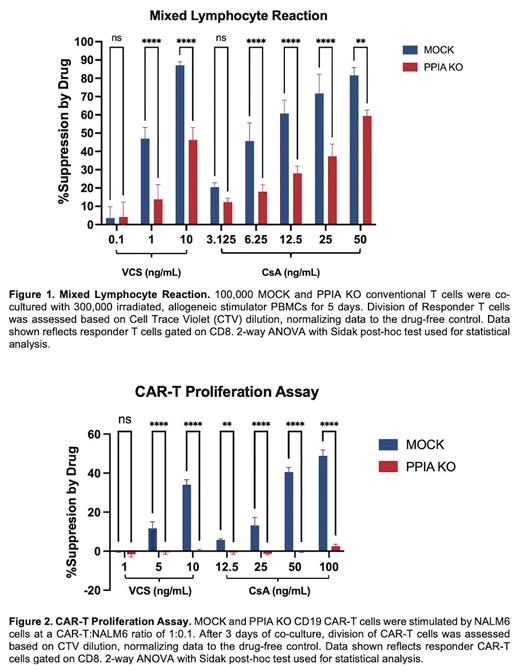Introduction: Relapse of a patient's underlying malignancy, and complications related to viral reactivation are prominent causes of morbidity and mortality after allogeneic hematopoietic cell transplantation (HCT). Immune effector cells (IEC) are increasingly deployed to prevent and treat these complications. These include anti-CD19 CAR-T-cells used for post-HCT B-ALL relapse, as well as viral specific T cells (VSTs) targeting EBV, CMV, and others. However, the efficacy of these IECs early after HCT may be compromised by the inhibitory effects of immunosuppressive agents used to prevent graft-versus host-disease (GVHD).
A commonly employed immunosuppressant used for GVHD prophylaxis is the calcineurin inhibitor (CNI) cyclosporine (CsA). A structural analog, voclosporin (VCS), is now FDA approved for lupus nephritis and in trials to prevent rejection after solid organ transplantation. Given its favorable pharmacodynamic and toxicity profile versus CsA and tacrolimus, VCS is poised to become an important option for HCT patients. Both CsA and VCS interact with calcineurin only in the presence of their immunophilin binding partner - cyclophilin A ( PPIA). Tacrolimus and sirolimus interact with a distinct immunophilin, FKBP12. This creates the opportunity to delete a single immunophilin (eg. PPIA) to create IECs resistant to one class of CNI (CsA/VCS) but sensitive to other immunosuppressive agents, an important safety feature. Here we developed CsA/VCS-resistant IECs by CRISPR/Cas9 knockout (KO) of PPIA. These cells exhibited superior proliferation and preserved effector function in the presence of CsA and VCS.
Methods: We developed IECs that are simultaneously resistant to both CsA and VCS via CRISPR-mediated KO of PPIA. Proliferation, cytotoxicity, and cytokine production of PPIA KO conventional T cells (Tcon), CMV (pp65)-specific VSTs, and CD19 CAR-T cells were tested against mock-edited (MOCK) cells in functional in vitro assays with escalating doses of CsA and VCS.
Results: PPIA KO Tcon demonstrated high editing efficiency (88-92%), high viability, and robust expansion in culture. Indeed, PPIA KO efficiency was maintained over several weeks in culture, suggestive of no survival disadvantage of cells bearing this deletion. Importantly, when PPIA KO cells were used as Responders in a mixed lymphocyte reaction in the presence of CsA, the edited cells demonstrated significant resistance to drug-mediated suppression of CD4+ and CD8+ T cell proliferation across the dose-response curve (p < 0.01; Fig. 1). Similar results were observed with VCS, with PPIA KO cells significantly resistant to VCS-mediated suppression across otherwise highly suppressive doses (p<0.0001; Fig. 1).
Having demonstrated that edited Tcon were resistant to CsA and VCS, we next sought to make PPIA KO IECs. CRISPR-edited VSTs and CD19 CAR-T cells showed similar editing efficiencies to Tcon. Consistent with prior results, CMV-specific PPIA KO responder VSTs were significantly resistant to suppression of proliferation by CsA vs MOCK cells at all doses tested (p=0.0004, not shown). Proliferation in the presence of drug was then assessed in KO CAR-T cells using the CD19+ NALM6 line as stimulators. Division of PPIA KO responder CD19 CAR-T cells was almost completely unaffected by CsA and VCS across escalating doses ( Fig. 2). For example, at an effector-to-target (E:T) ratio of 1:0.1 and a CsA dose of 50 ng/mL, there was 40.6 ± 2.3 % suppression of division in MOCK CD8+ CAR-T cells vs. -0.2 ± 0.4 % in PPIA KO CD8+ CAR-T cells (p<0.0001). Similar findings were observed with CD4+ responder CAR-T cells (p<0.0001, not shown). PPIA KO CAR-T cells also demonstrated intact cytotoxic function with no significant differences in % killing between the MOCK and PPIA KO groups at 3 different E:T ratios. For example, at a 1:1 E:T ratio, there was 59 ± 15% killing vs. 55 ± 12% killing in MOCK vs PPIA KO groups, respectively (not shown).
Conclusion: KO of PPIA is an effective strategy for engineering resistance to CsA and VCS incellular therapies. Our results demonstrate that PPIA KO conventional T cells, VSTs, and CAR-T cells were markedly resistant to the otherwise suppressive effects on T cell proliferation that are hallmarks of both CsA and VCS. Engineering CNI-resistance into IECs will enhance the ability to deploy these cells early after transplant to prevent or treat both malignant relapse and viral reactivation.
Disclosures
Blazar:BlueRock Therapeutics: Current Employment, Membership on an entity's Board of Directors or advisory committees; Carisma Therapeutics: Current Employment, Research Funding. Gerdemann:Allovir: Patents & Royalties. Kean:Merck EMD Serono: Research Funding; Novartis: Research Funding; Tessera: Research Funding; Vertex: Consultancy, Membership on an entity's Board of Directors or advisory committees; Bristol Myers squibb: Patents & Royalties: royalties for clinical trial results., Research Funding; HiFiBio: Consultancy, Membership on an entity's Board of Directors or advisory committees; Mammoth: Consultancy, Current equity holder in private company, Membership on an entity's Board of Directors or advisory committees; Vor: Other: Materials Transfer Agreement; Regeneron: Research Funding; Gilead: Research Funding.


This feature is available to Subscribers Only
Sign In or Create an Account Close Modal